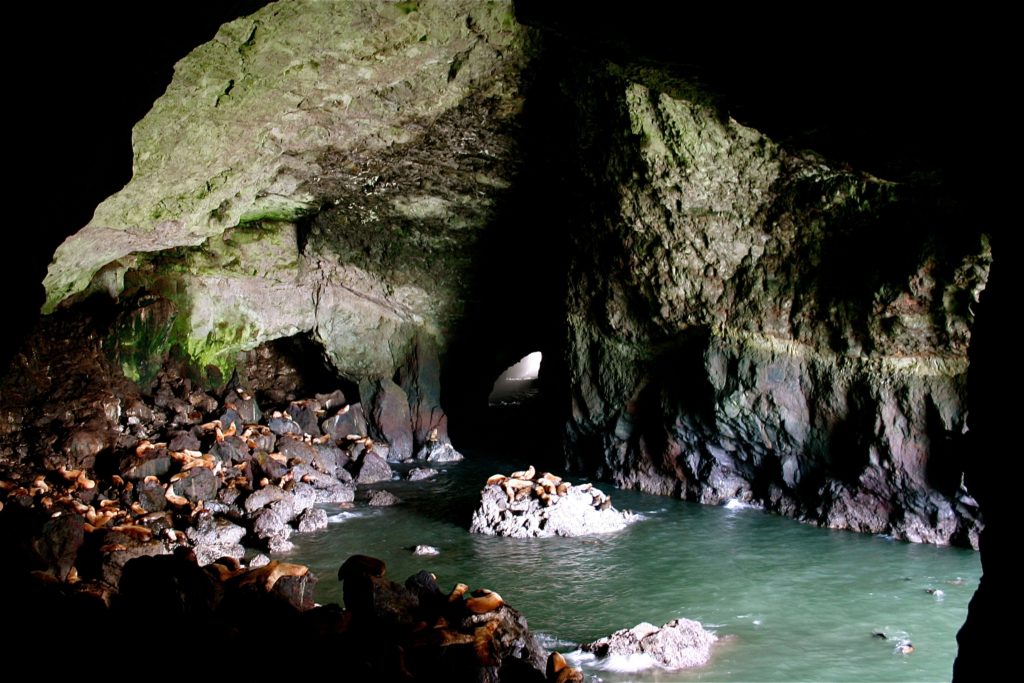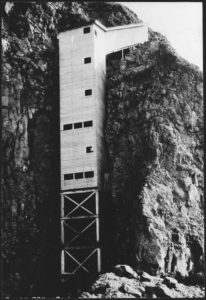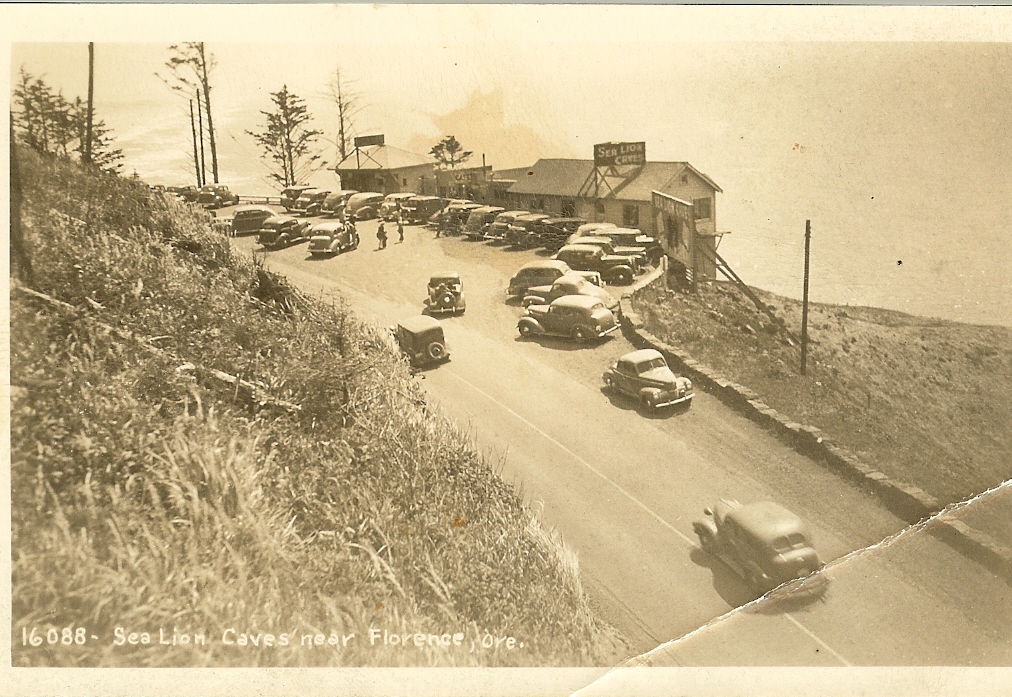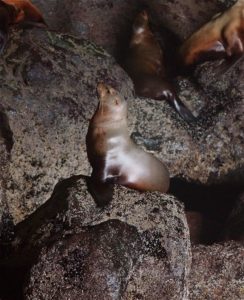
By Oregon ArtsWatch
Take a drive along the U.S. Highway 101 and you’ll find no end of reasons to stop and gape – the amazing views, iconic bridges and lighthouses, and that singular landmark between Yachats and Florence — the Sea Lion Caves.
True, you can watch sea life from any number of spots along Highway 101, but where else – possibly in the world — can you take an elevator ride 208 feet into what feels like the belly of the Earth to stand so close and safely so? Visitors have been making the trip – originally by stairs – since 1932, making this the caves’ 90th birthday. The largest sea cave in the United States – about two acres with a 125-foot rock dome – the caves are home to some 200 Stellar sea lions.
Steve Saubert’s family has been there from nearly the start. The Siuslaw Pioneer Museum in nearby Florence has a special exhibit dedicated to the caves.
The property was bought from the state in 1887 by William Cox, a sea captain who took lumber to San Francisco and brought groceries back.

Saubert said when Cox died, developer R.E. Clanton, aware that a highway would soon be built along the coast, bought it in 1927 and hired two younger men, J.G. “Gib” Houghton and J.E. Jacobson, to help with the manual labor of creating a pathway to the caves. Local lore has it that people used to shoot the sea lions on the rocks below, and Clanton, something of an early environmentalist, shot back.
“I don’t know if that’s true,” Saubert said, “but that’s the folklore.”
Clanton’s hired hands grew tired of the old man bossing them around and the partnership was dissolved on the steps of the Eugene courthouse. That’s when Saubert’s grandfather, Roy Saubert, persuaded a bank to loan him $500 to invest in the site.
By 1932, the 135-step stairway was complete. While the men traveled to Portland for work, Saubert’s grandmother managed the caves.
“She had a little coffee can, and back then it was 25 cents to go on the tour,” Saubert said. “She put up a sign, ‘I’m on a tour. Back in 35 minutes.’ Then she would take a group to the caves and show them around.”
Seven years later, the cave suffered one of the darker moments of its history when Roy Saubert died while inspecting the staircase.
“It was an extremely rough ocean,” Saubert said. “He was always worried about the foundation of the stairway washing out. Gib Houghton and my grandfather went down to inspect it. A big wave came along and washed them off. Gib was able to grab on to the rocks. They never found my grandfather’s body.”
In 1970, the families decided the caves needed a general manager and the young Steve Saubert was it.
“I was the only one of the offspring that had any experience up there at all. Believe me, I grew up behind the counter.”
He remembers dirty, oily floors and a massive old cash register with a crank he was too little to work. It served little purpose anyway because “all they needed was a bucket for quarters.”
What he called a cracker-box building burned in 1946 – the cause unknown.

The families rebuilt the visitor center, the crowds kept coming and life was about to get easier for those seeking an up-close encounter with the pinnipeds. If building a stair tower was smart, upgrading to an elevator 26 years later was brilliant – and something you’d never pull off today.
The project started in 1958 and took three years to finish. First, they built the 70-foot drift – horizontal — tunnel. Then the 208-foot shaft. They moved the rock with “very tiny” charges, Saubert said, blasting only during the months when the sea lions leave for breeding season.
“That gave everybody a few gray hairs if they had any hair to begin with,” Saubert said. “The local bank at the time wouldn’t even look at us for financing. It was $180,000 for the entire job.”
Eventually, a bank in Newport agreed to put up the loan but only with the help of two other larger banks.
The elevator was finished in 1961 – one year before the Seattle World’s Fair got underway, making the caves an added bonus for the visitors driving north and south to the fair.
In the decades since, the caves haven’t changed dramatically, though there have been some newsworthy events. When the bones and hide of a female sea lion were found in the caves, scientists estimated the animal to have died 400 years ago, the body preserved by the salt air and sea. The skeleton is part of the permanent display.
In 2010, staff from the Hatfield Marine Science Center in Newport were able to rescue a female sea lion who’d become entangled in a net.
“That was pretty hairy – saving the sea lion,” Saubert said. “The marine mammals act doesn’t allow us to do anything. It’s amazing. If one is dying, the marine mammals act says that’s part of nature and it happens. But the Marine Science Center was able to come down. This sea lion had a huge fishing flasher in its mouth. They came in and cut that off so she wasn’t entangled anymore.”
More recently, and on a happier note, the Sea Lion Caves sponsored Dancing with the Sea Lions, a fundraiser for the Florence Events Center that saw 20 sea lion sculptures painted and planted from Waldport to Reedsport.

Ninety years since the stair tower opened the way to the rocky shores below, the Sea Lion Caves are still under the care of the Saubert and Jacobson families. They bought out the Houghtons about 15 years ago.
Saubert doesn’t see too much changing, though he notes, “We always try to add something to the attraction.
“The Sea Lion Caves exist today because from day one in 1932 the philosophy was and has always been based on preservation of the resource. As long as we are the Sea Lion Caves custodians, this is what we will carry into the future.”
- This story was originally published by our community partner Oregon ArtsWatch. It is supported in part by a grant from the Oregon Cultural Trust, investing in Oregon’s arts, humanities and heritage. For more arts news coverage go to Oregon ArtsWatch.



Wonderful piece. Thanks for sharing here!